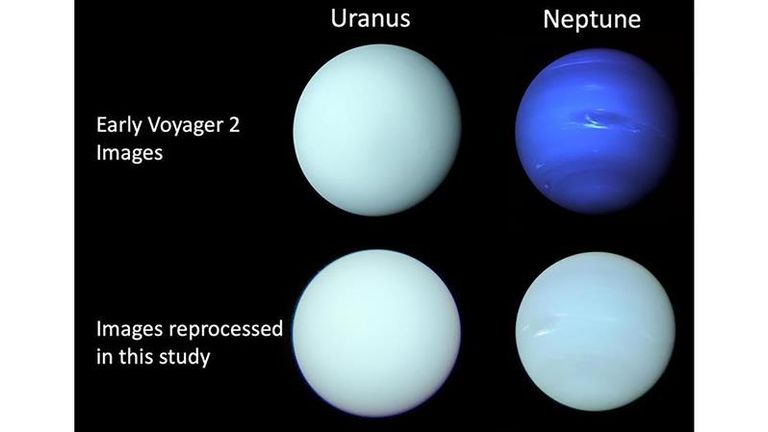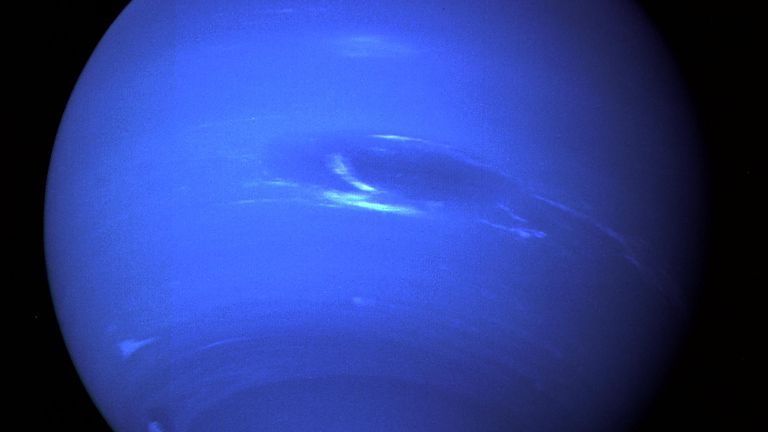New images have revealed Neptune and Uranus look more like each other than was previously thought.
Many people will think of Neptune as being a rich blue colour, and Uranus more green.
However, Professor Patrick Irwin from the University of Oxford and his team found that the two ice giants, the most distant planets in our solar system, are a similar shade of greenish blue.
Experts suggest the idea that both planets were different colours arose because images of them captured in the 20th century – including by NASA’s Voyager 2 mission in the 1980s – recorded images in separate colours.
The single-colour images were later recombined to create composite colour images, which were not always accurately balanced to achieve a true colour image.
Particularly in the case of Neptune, these composites were often made too blue.
Early images of Neptune from Voyager 2 were strongly contrast-enhanced to better reveal the clouds, bands, and winds that shape what we have come to think the planet looks like, scientists say.
Prof Irwin said: “Although the familiar Voyager 2 images of Uranus were published in a form closer to ‘true’ colour, those of Neptune were, in fact, stretched and enhanced, and therefore made artificially too blue.”
“Even though the artificially saturated colour was known at the time amongst planetary scientists – and the images were released with captions explaining it – that distinction had become lost over time.”
He added: “Applying our model to the original data, we have been able to reconstitute the most accurate representation yet of the colour of both Neptune and Uranus.”
In the new study, the researchers used data from Hubble Space Telescope’s Space Telescope Imaging Spectrograph (STIS) and the Multi Unit Spectroscopic Explorer (MUSE) on the European Southern Observatory’s Very Large Telescope.
In both the STIS and the MUSE, each pixel is a continuous spectrum of colours, meaning observations from them can be processed to determine the true apparent colour of Uranus and Neptune.
The researchers used the data to re-balance the composite colour images recorded by the Voyager 2 camera, and also by the Hubble Space Telescope’s Wide Field Camera 3.
However, the study also found that Neptune has a slight hint of additional blue, which the model reveals to be due to a thinner haze layer on that planet.
The study also provides an answer to the long-standing mystery of why Uranus’s colour changes slightly during its 84-year orbit of the sun.
According to the findings, this is because of how thick certain gases are at the planet’s north and south poles, and how they appear when these poles are closest to the sun.
Read more:
Microsoft to add AI button to PC keyboards
Teenager becomes first person to ‘beat’ Tetris
AI Elvis to star on UK stage for first time
Prof Irwin said: “This is the first study to match a quantitative model to imaging data to explain why the colour of Uranus changes during its orbit.”
“In this way, we have demonstrated that Uranus is greener at the solstice due to the polar regions having reduced methane abundance but also an increased thickness of brightly scattering methane ice particles.”
Dr Heidi Hammel, of the Association of Universities for Research in Astronomy, who has spent decades studying Neptune and Uranus but was not involved in the study, said: “The misperception of Neptune’s colour, as well as the unusual colour changes of Uranus, have bedevilled us for decades.
“This comprehensive study should finally put both issues to rest.”
The findings are published in Monthly Notices of the Royal Astronomical Society.




